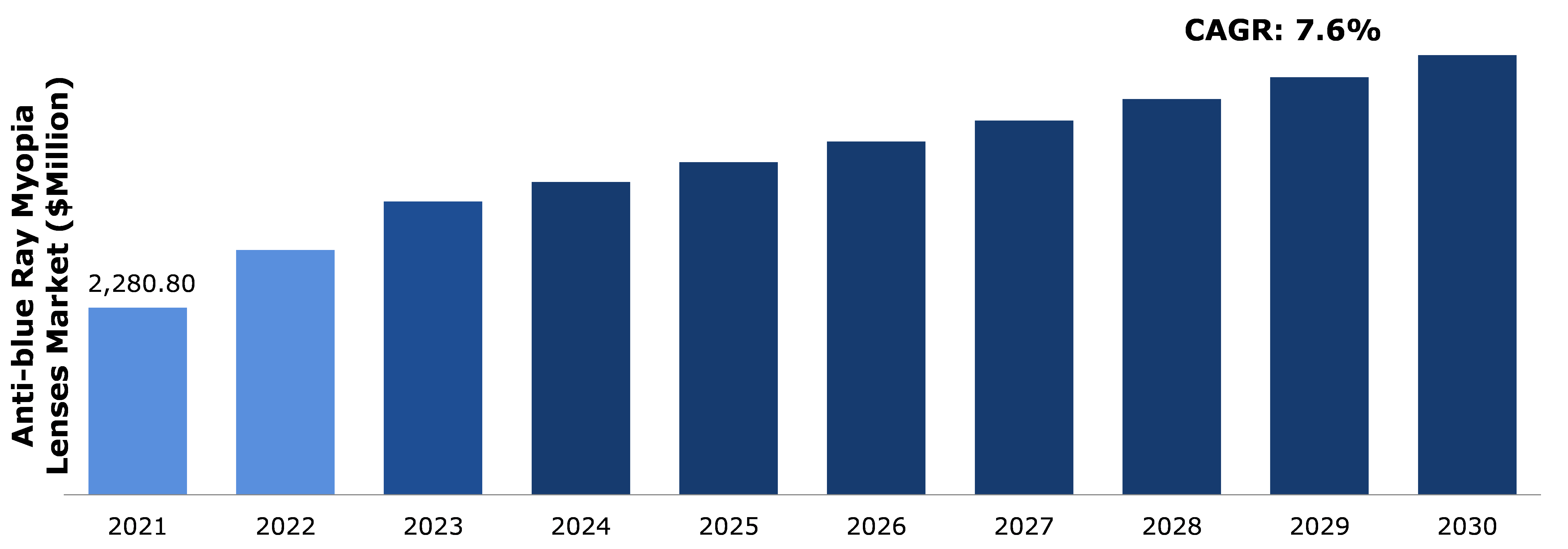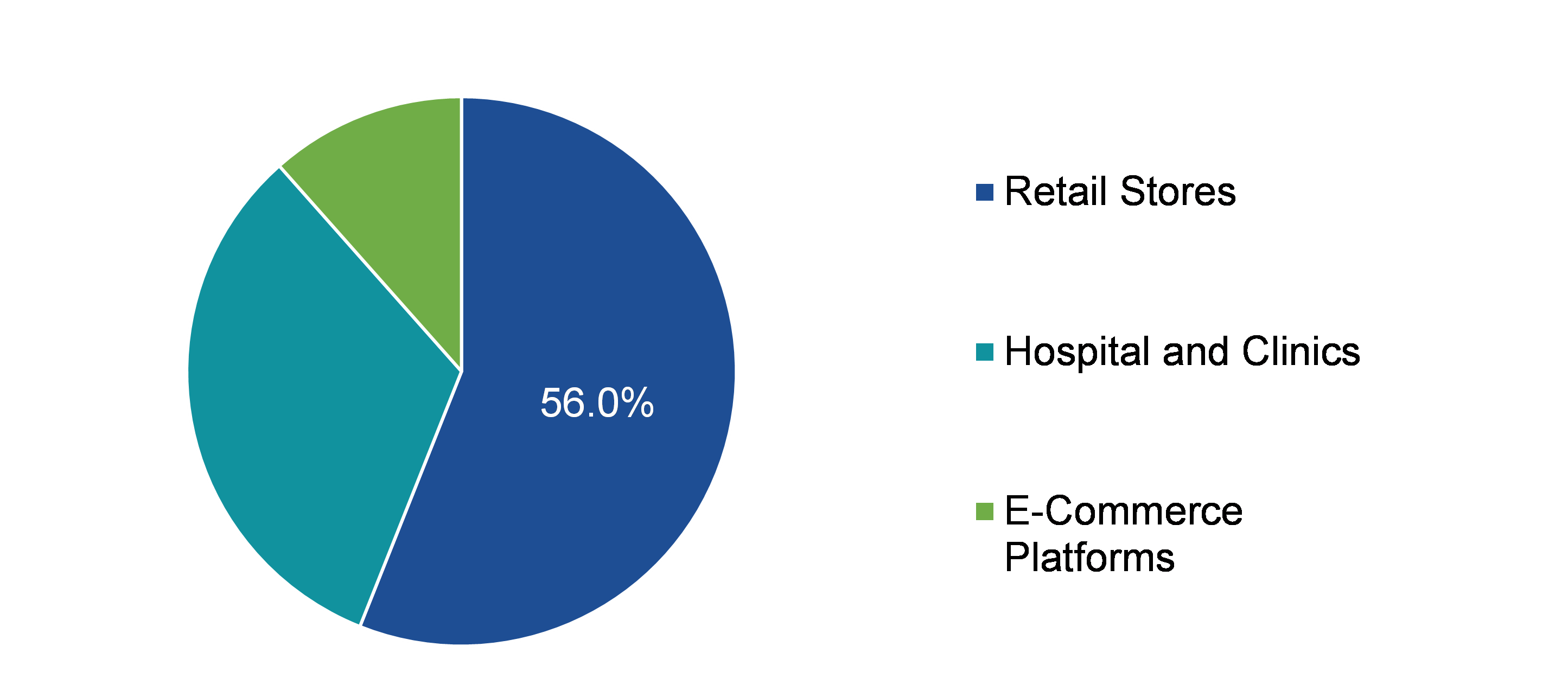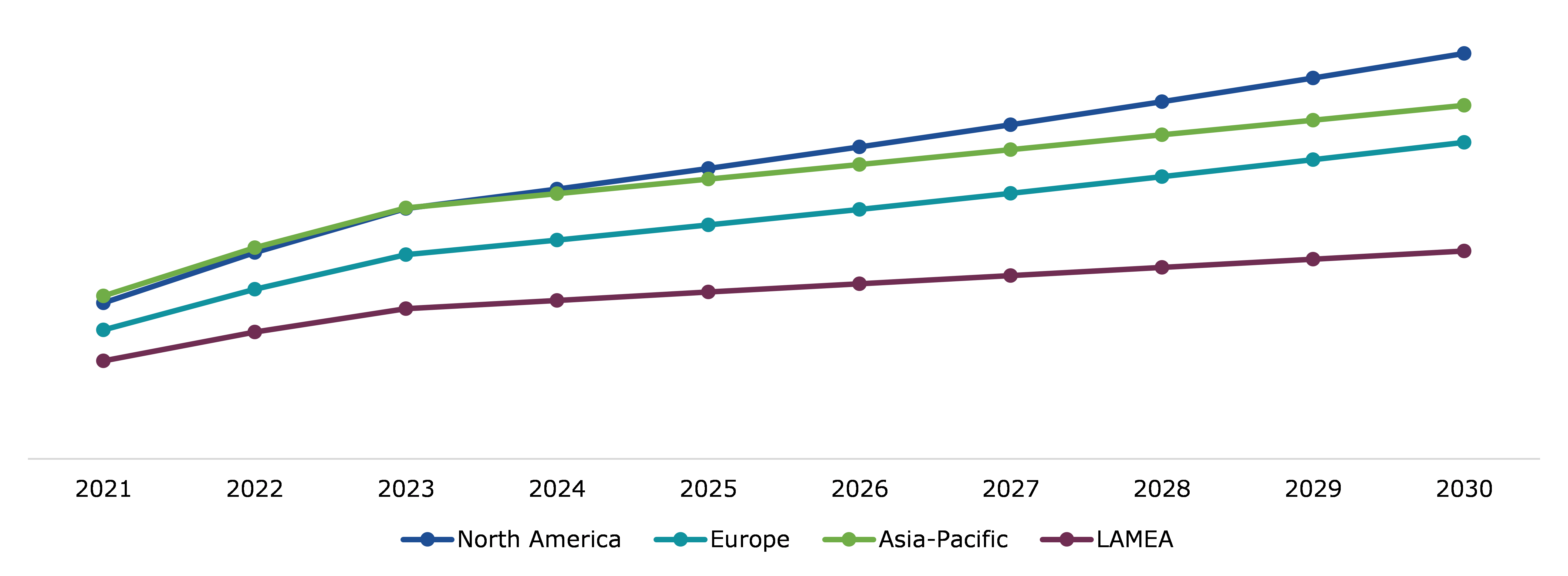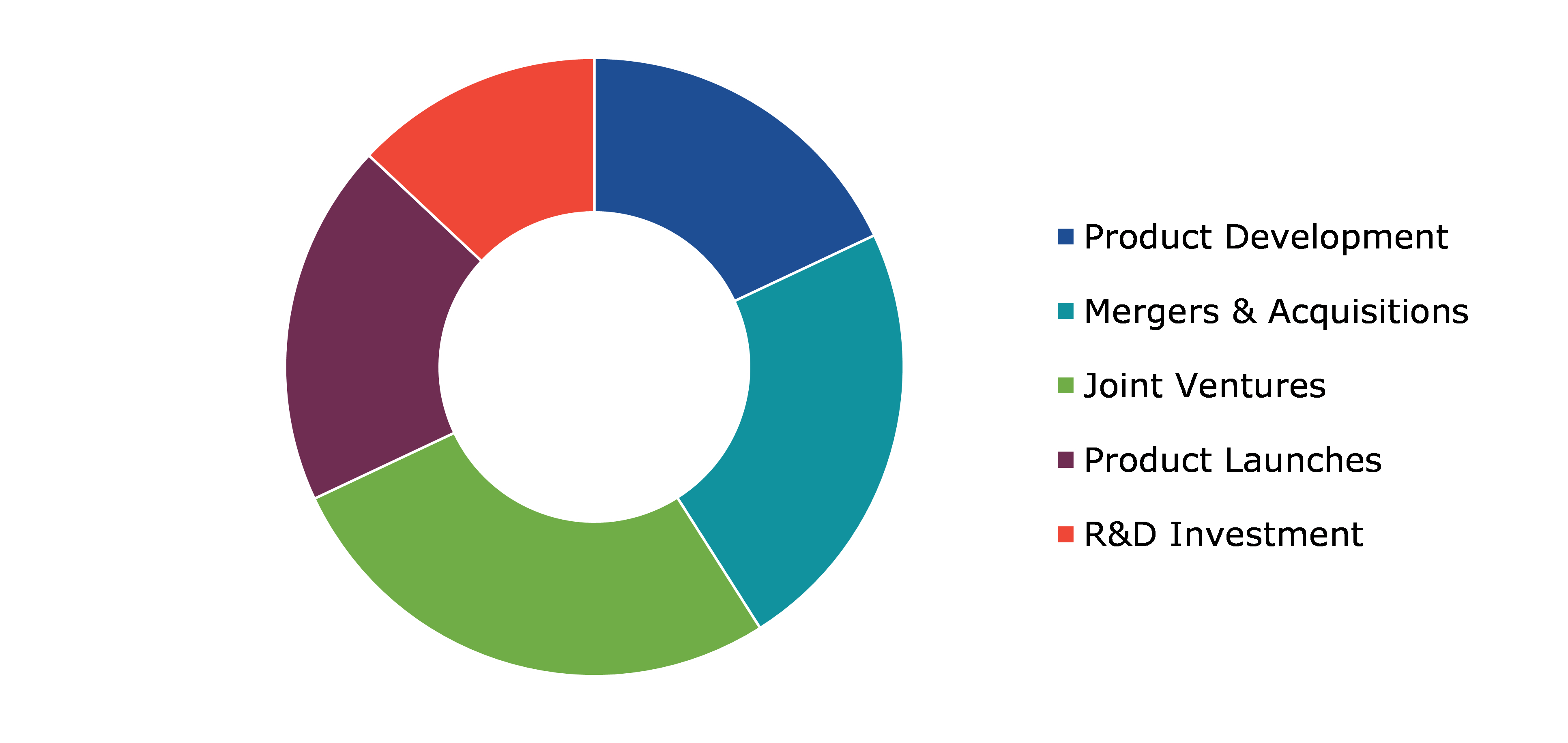Anti-blue Ray Myopia Lenses Market Report
RA08356
Anti-blue Ray Myopia Lenses Market by Type (Single, Bifocal, Trifocal, and Others), Distribution Channel (Retail Stores, Hospital & Clinics, and E-Commerce Platforms), and Regional Analysis (North America, Europe, Asia-Pacific, and LAMEA): Global Opportunity Analysis and Industry Forecast, 2022-2030
Global Anti-blue Ray Myopia Lenses Market Analysis
The global anti-blue ray myopia lenses market size was $2,280.80 million in 2021 and is predicted to grow with a CAGR of 7.6%, by generating a revenue of $5,361.10 million by 2030.
Global Anti-blue Ray Myopia Lenses Market Synopsis
Blue light has an impact on eye health and contributes to conditions such as cataract, age-related macular degeneration, dry eye, and eyestrain. As a result, anti-blue ray myopia lenses are used to shield myopia sufferers' eyes from dangerous blue rays. Additionally, according to the Vision Council of America reports, the blue light exposure affects more than 65% of American users of smart phones, computers, and LED screens. The circadian rhythm and sleep cycles are disturbed by the blue lights, which also dry up the eyes. People are becoming more conscious of the need for anti-blue ray lenses as a result of these ailments, which is boosting the market expansion. These factors are anticipated to boost the anti-blue ray myopia lenses market growth in the upcoming years.
However, anti-blue ray myopia lenses have some adverse effects, including the acceleration of scotopic vision loss and a yellowish tint to everything one sees when wearing blue light glasses. During the projected period, several important issues such as high cost of anti-blue ray lenses can have a negative effect on the market.
Future market potential could be enormous as a result of the rising adoption of fashion trends. The use of eyewear has become fashionable in recent years, and many people follow the most recent anti-blue ray myopia lenses market trends. Additionally, it is anticipated that the rise in myopia among young people and children would increase demand for anti-blue ray myopia lenses. In addition, a study published in the journal ‘Investigative Ophthalmology and Visual Science’ in 2019 found that 32% of individuals worldwide suffer from myopia, an eye ailment that makes it difficult to see clearly objects that are far away, and that number is expected to rise to 60% by the year 2050. Myopia is predicted to impact an increasing number of people, which will increase the adoption of anti-blue ray myopia lenses trend. This could create attractive anti-blue ray myopia lenses market growth prospects for major companies in the coming years.
According to regional analysis, the Asia-Pacific anti-blue ray myopia lenses market share accounted for $680.40 million in 2021 and is predicted to grow with a CAGR of 6.6% in the projected timeframe. The increase of children with myopia in Asian nations such as China, India, and Japan is expected to be a result of more time spent studying or playing video games on screens while using mobile phones.
Anti-blue Ray Myopia Lenses Overview
The hazardous blue lights released from digital gadgets such as smartphones, laptops, LEDs, televisions, and other similar devices are blocked by anti-blue ray myopia lenses. Blue light has an impact on eye health and leads to conditions such as cataract, age-related macular degeneration, dry eye, and eyestrain. As a result, anti-blue ray myopia lenses are used to shield myopia sufferers' eyes from dangerous blue rays.
COVID-19 Impact on Global Anti-blue Ray Myopia Lenses Market
Although many sectors were severely impacted by the new coronavirus pandemic, the market for anti-blue ray myopia lenses saw tremendous development at this time. During the government-enforced lockdown that was put in place to stop the spread of the coronavirus sickness, most individuals spent more time on their digital screens, computers, and mobile devices. People were exposed to blue light for extended period of time, which negatively impacted the majority of people's eye health. As a result, there was a rise in the demand for anti-blue ray lenses. Additionally, due to increased screen time during the pandemic, people have been experiencing problems including as eye strain and dryness from excessive blue light contact. As a result, the COVID-19 impact on anti-blue ray myopia lenses market the value of maintaining good eye health has increased dramatically, driving the market expansion. Additionally, a number of businesses are using their strategic plans and actions to assist society in recovering from the chaotic circumstances. For instance, ZENNI OPTICAL, an optical retail company, reported in January 2021, that sales of blue-light filtering lenses had increased up to 60% yearly compared to the previous two years, with a sale of 2 million pairs in 2020. The aforementioned factors indicate that the pandemic may result in significant market investment opportunities in the upcoming years.
Decreasing Possibility of Migraines & Macular Degeneration to Accelerate the Market Growth
The growth in demand for anti-blue ray myopia lenses is not just a random phenomenon or an aberration. Some of the benefits of using anti-blue ray myopia are it decreases the possibility of migraines and macular degeneration which is key driving factor of anti-blue ray myopia lenses market. Blue light exposure on a regular basis may raise the risk of macular degeneration, as per analysis, even though a strong link between the two conditions has not yet been conclusively demonstrated. So as to reduce the likelihood of developing this condition, several specialists suggest wearing anti-blue ray myopia lenses on a regular basis. Additionally, migraines and headaches are directly linked to eye strain in a cause-and-effect manner. In this way, these lenses can lessen both the frequency and the severity of migraines.
To know more about global anti-blue ray myopia lenses market drivers, get in touch with our analysts here.
Higher Cost of Anti-blue Ray Lenses to Restrain the Market Growth
The price of anti-blue ray myopia lenses is higher than that of regular myopia lenses. During the forecast period, this factor is anticipated to impede the expansion of the global market. The average price of non-anti-blue ray myopia lenses is $17, while the average price of normal myopia lenses is $8. Therefore, rising prices could have a detrimental effect on the market expansion during the forecasted time. Furthermore, anti-reflective finishes are not flawless. They do have their own particular set of drawbacks. The fact that anti-reflective coating glasses are more expensive than conventional eyeglasses is their main disadvantage. For other people, who require them but lack the resources to buy them, this can be challenging. Additionally, the fact that these glasses are not regarded as medical necessities makes it difficult for people without insurance coverage.
Increasing Fashion Trends to Open Up Vast Investment Opportunities
Improving living standards are encouraging consumers to purchase top-quality items for eye protection. The market for anti-blue ray myopia lenses is expanding extremely quickly on a global scale. According to anti-blue ray myopia lenses market trends, consumers all around the world are choosing fashionable and designer eyewear. Additionally, the market for eyewear is anticipated to rise due to the rising trend of virtual try-ons on eyewear websites. Customers can select glasses from the comfort of their own homes by using the virtual try-ons to suit their tastes, wants, and preferences. The anti-blue ray myopia lenses market outlook expansion for anti-blue ray myopia lenses is therefore positively impacted by rising fashion consciousness and living standards, both of which are significant growth-accelerating factors.
To know more about global anti-blue ray myopia lenses market opportunities, get in touch with our analysts here.
Global Anti-blue Ray Myopia Lenses Market Share, by Type
Based on type, the market has been divided single, bifocal, trifocal, and others. Among these, the single sub-segment accounted for the highest market share in 2021 and expected to witness fastest growth during the forecast period. The bifocal sub-segment accounted for the second highest anti-blue ray myopia lenses market share in 2021 and projected to register fastest growth during the forecast period.
Global Anti-blue Ray Myopia Lenses Market Size, by Type, 2021
Source: Research Dive Analysis
The single sub-type is anticipated to have a dominant market share and generate a revenue of $2,666.50 million by 2030, growing from $1,072.90 million in 2021. The majority of persons under the age of 40 who need to correct their nearsightedness and farsightedness use single focal lenses. Additionally, for a large portion of the population, this kind of lens is the most economical. Furthermore, major industry companies are forming strategic alliances to provide customers with the greatest anti-blue ray lenses possible. For instance, Essilor announced the release of a new single vision prescription lens called Eyezen in January 2019. It has an advanced blue blocking light filter, a finely tuned surface to offer sharp vision, and is made in such a way that it deflects harmful blue lights while allowing beneficial blue light to pass through the lens.
The bifocal sub-type is anticipated to show the second highest fastest growth and generate a revenue of $1,959.60 million by 2030, increasing from $807.70 million in 2021. By using bifocal lenses, it is not necessary to change glasses when performing two vision correction jobs. Bifocal lenses are used for people who are both nearsighted and farsighted. Bifocals are a useful treatment for many individuals. Instead of needing two pairs—one for driving and one for reading—a wearer can have just one set of glasses that makes everything simple to perform. These are predicted to be the major factors affecting the anti-blue ray myopia lenses market size during the forecast period.
Global Anti-blue Ray Myopia Lenses Market Trends, by Distribution Channel
Based on distribution channel, the market has been divided into retail stores, hospital & clinics, and e-commerce platforms. Among these, the retail stores sub-segment accounted for highest revenue share in 2021.
Global Anti-blue Ray Myopia lenses Market Value, by Distribution Channel, 2021
Source: Research Dive Analysis
The retail stores sub-segment is anticipated to have a dominant market share and generate a revenue of $3,148.50 million by 2030, growing from $1,278.00 million in 2021. This market expansion can be ascribed to an increase in the number of consumers who favor retail establishments such as independent stores, wholesalers, and brand chains. This is due to the vast variety of lenses that retail stores offer, ranging from budget-friendly to high-end brands, which is said to be one of the causes influencing people to purchase eyewear or lenses from retail stores. Additionally, a lot of the retail establishments provide inexpensive or complimentary annual eye exams by licensed optometrists. All of these factors could raise consumer demand for retail establishments and accelerate industry expansion. These factors are anticipated to boost the growth of retail stores sub-segment during the analysis timeframe.
Global Anti-blue Ray Myopia Lenses Market Growth, Regional Insights
The anti-blue ray myopia lenses market was investigated across North America, Europe, Asia-Pacific, and LAMEA.
Global Anti-blue Ray Myopia Lenses Market Size & Forecast, by Region, 2021-2030 (USD Million)
Source: Research Dive Analysis
The Market for Anti-blue Ray Myopia Lenses in Asia-Pacific to be the Most Dominant
The Asia-Pacific anti-blue ray myopia lenses market accounted $680.40 million in 2021 and is projected to grow with a CAGR of 6.6%. Myopia is becoming more common among children in Asian nations including China, India, and Japan as a result of more time spent studying or playing video games on screens while using mobile phones. Myopia has been quickly increasing among children in Southeast Asian and Eastern countries over the past 60 years as a result of educational pressure on schoolchildren, according to a review report from the NCBI (National Center for Biotechnology Information) published in May 2020. Such studies demonstrate that, in the following years, the Asia-Pacific anti-blue ray myopia lenses market will be stimulated by the exponential growth in demand for anti-blue ray myopia lenses. Also, anti-blue ray myopia lenses are used to block the harmful blue lights emitted from digital devices such as smart phones, laptops, LEDs, television, and other similar devices, owing to anti-blue ray myopia lenses is gaining significant popularity.
Competitive Scenario in the Global Anti-blue Ray Myopia Lenses Market
Investment and agreement are common strategies followed by major market players. For instance, in February 2021, the optical business ZEISS, which is based in Germany, has announced the release of their ZEISS Blue Guard line of blue light-blocking lenses. The lens's construction offers clarity and shields harmful blue light by up to 40%. Such technological developments may also result in profitable market prospects in the next years.
Source: Research Dive Analysis
Some of the leading anti-blue ray myopia lenses market players are Essilor, HOYA Corporation, RODENSTOCK GMBH, ZEISS, Seiko, Chemiglas Corp., Nikon, Shamir Optical Industry Ltd, Mingyue Glasses Co., Ltd., and Shanghai Conant Optics Co., Ltd.
| Aspect | Particulars |
| Historical Market Estimations | 2020 |
| Base Year for Market Estimation | 2021 |
| Forecast Timeline for Market Projection | 2022-2030 |
| Geographical Scope | North America, Europe, Asia-Pacific, and LAMEA |
| Segmentation by Type |
|
| Segmentation by Distribution Channel |
|
| Key Companies Profiled |
|
Q1. What is the size of the global anti-blue ray myopia lenses market?
A. The size of the global anti-blue ray myopia lenses market was over $2,280.80 million in 2021 and is projected to reach $5,361.10 million by 2030.
Q2. Which are the major companies in the anti-blue ray myopia market?
A. Essilor, HOYA GROUP, and Zeiss are some of the key players in the global anti-blue ray myopia lenses market.
Q3. Which region, among others, possesses greater investment opportunities in the near future?
A. The North America region possesses great investment opportunities for investors to witness the most promising growth in the future.
Q4. What will be the growth rate of the North America anti-blue ray myopia lenses market?
A. North America anti-blue ray myopia lenses market is anticipated to grow at 8.8% CAGR during the forecast period.
Q5. What are the strategies opted by the leading players in this market?
A. Agreement and investment are the two key strategies opted by the operating companies in this market.
Q6. Which companies are investing more on R&D practices?
A. Essilor and HOYA Corporation are investing more on R&D activities for developing new products and technologies.
1.Research Methodology
1.1.Desk Research
1.2.Real time insights and validation
1.3.Forecast model
1.4.Assumptions and forecast parameters
1.5.Market size estimation
1.5.1.Top-down approach
1.5.2.Bottom-up approach
2.Report Scope
2.1.Market definition
2.2.Key objectives of the study
2.3.Report overview
2.4.Market segmentation
2.5.Overview of the impact of COVID-19 on Global anti-blue ray myopia lenses market
3.Executive Summary
4.Market Overview
4.1.Introduction
4.2.Growth impact forces
4.2.1.Drivers
4.2.2.Restraints
4.2.3.Opportunities
4.3.Market value chain analysis
4.3.1.List of raw material suppliers
4.3.2.List of manufacturers
4.3.3.List of distributors
4.4.Innovation & sustainability matrices
4.4.1.Technology matrix
4.4.2.Regulatory matrix
4.5.Porter’s five forces analysis
4.5.1.Bargaining power of suppliers
4.5.2.Bargaining power of consumers
4.5.3.Threat of substitutes
4.5.4.Threat of new entrants
4.5.5.Competitive rivalry intensity
4.6.PESTLE analysis
4.6.1.Political
4.6.2.Economical
4.6.3.Social
4.6.4.Technological
4.6.5.Environmental
4.7.Impact of COVID-19 on anti-blue ray myopia lenses market
4.7.1.Pre-covid market scenario
4.7.2.Post-covid market scenario
5.Anti-blue Ray Myopia Lenses Market Analysis, by Type
5.1.Overview
5.2.Single
5.2.1.Definition, key trends, growth factors, and opportunities
5.2.2.Market size analysis, by region,2021-2030
5.2.3.Market share analysis, by country,2021-2030
5.3.Bifocal
5.3.1.Definition, key trends, growth factors, and opportunities
5.3.2.Market size analysis, by region,2021-2030
5.3.3.Market share analysis, by country,2021-2030
5.4.Trifocal
5.4.1.Definition, key trends, growth factors, and opportunities
5.4.2.Market size analysis, by region,2021-2030
5.4.3.Market share analysis, by country,2021-2030
5.5.Others
5.5.1.Definition, key trends, growth factors, and opportunities
5.5.2.Market size analysis, by region,2021-2030
5.5.3.Market share analysis, by country,2021-2030
5.6.Research Dive Exclusive Insights
5.6.1.Market attractiveness
5.6.2.Competition heatmap
6.Anti-blue Ray Myopia Lenses Market Analysis, by Distribution Channel
6.1.Retail Stores
6.1.1.Definition, key trends, growth factors, and opportunities
6.1.2.Market size analysis, by region,2021-2030
6.1.3.Market share analysis, by country,2021-2030
6.2. Hospital & Clinics
6.2.1.Definition, key trends, growth factors, and opportunities
6.2.2.Market size analysis, by region,2021-2030
6.2.3.Market share analysis, by country,2021-2030
6.3.E-Commerce Platforms
6.3.1.Definition, key trends, growth factors, and opportunities
6.3.2.Market size analysis, by region,2021-2030
6.3.3.Market share analysis, by country,2021-2030
6.4.Research Dive Exclusive Insights
6.4.1.Market attractiveness
6.4.2.Competition heatmap
7.Anti-blue Ray Myopia Lenses Market, by Region
7.1.North America
7.1.1.U.S.
7.1.1.1.Market size analysis, by Type,2021-2030
7.1.1.2.Market size analysis, by Distribution Channel,2021-2030
7.1.2.Canada
7.1.2.1.Market size analysis, by Type,2021-2030
7.1.2.2.Market size analysis, by Distribution Channel,2021-2030
7.1.3.Mexico
7.1.3.1.Market size analysis, by Type,2021-2030
7.1.3.2.Market size analysis, by Distribution Channel,2021-2030
7.1.4.Research Dive Exclusive Insights
7.1.4.1.Market attractiveness
7.1.4.2.Competition heatmap
7.2.Europe
7.2.1.Germany
7.2.1.1.Market size analysis, by Type,2021-2030
7.2.1.2.Market size analysis, by Distribution Channel,2021-2030
7.2.2.UK
7.2.2.1.Market size analysis, by Type,2021-2030
7.2.2.2.Market size analysis, by Distribution Channel,2021-2030
7.2.3.France
7.2.3.1.Market size analysis, by Type,2021-2030
7.2.3.2.Market size analysis, by Distribution Channel,2021-2030
7.2.4.Spain
7.2.4.1.Market size analysis, by Type,2021-2030
7.2.4.2.Market size analysis, by Distribution Channel,2021-2030
7.2.5.Italy
7.2.5.1.Market size analysis, by Type,2021-2030
7.2.5.2.Market size analysis, by Distribution Channel,2021-2030
7.2.6.Rest of Europe
7.2.6.1.Market size analysis, by Type,2021-2030
7.2.6.2.Market size analysis, by Distribution Channel,2021-2030
7.2.7.Research Dive Exclusive Insights
7.2.7.1.Market attractiveness
7.2.7.2.Competition heatmap
7.3.Asia-Pacific
7.3.1.China
7.3.1.1.Market size analysis, by Type,2021-2030
7.3.1.2.Market size analysis, by Distribution Channel,2021-2030
7.3.2.Japan
7.3.2.1.Market size analysis, by Type,2021-2030
7.3.2.2.Market size analysis, by Distribution Channel,2021-2030
7.3.3.India
7.3.3.1.Market size analysis, by Type,2021-2030
7.3.3.2.Market size analysis, by Distribution Channel,2021-2030
7.3.4.Australia
7.3.4.1.Market size analysis, by Type,2021-2030
7.3.4.2.Market size analysis, by Distribution Channel,2021-2030
7.3.5.South Korea
7.3.5.1.Market size analysis, by Type,2021-2030
7.3.5.2.Market size analysis, by Distribution Channel,2021-2030
7.3.6.Rest of Asia-Pacific
7.3.6.1.Market size analysis, by Type,2021-2030
7.3.6.2.Market size analysis, by Distribution Channel,2021-2030
7.3.7.Research Dive Exclusive Insights
7.3.7.1.Market attractiveness
7.3.7.2.Competition heatmap
7.4.LAMEA
7.4.1.Brazil
7.4.1.1.Market size analysis, by Type,2021-2030
7.4.1.2.Market size analysis, by Distribution Channel,2021-2030
7.4.2.Saudi Arabia
7.4.2.1.Market size analysis, by Type,2021-2030
7.4.2.2.Market size analysis, by Distribution Channel,2021-2030
7.4.3.UAE
7.4.3.1.Market size analysis, by Type,2021-2030
7.4.3.2.Market size analysis, by Distribution Channel,2021-2030
7.4.4.South Africa
7.4.4.1.Market size analysis, by Type,2021-2030
7.4.4.2.Market size analysis, by Distribution Channel,2021-2030
7.4.5.Rest of LAMEA
7.4.5.1.Market size analysis, by Type,2021-2030
7.4.5.2.Market size analysis, by Distribution Channel,2021-2030
7.4.6.Research Dive Exclusive Insights
7.4.6.1.Market attractiveness
7.4.6.2.Competition heatmap
8.Competitive Landscape
8.1.Top winning strategies, 2021
8.1.1.By strategy
8.1.2.By year
8.2.Strategic overview
8.3.Market share analysis, 2021
9.Company Profiles
9.1.HOYA Corporation
9.1.1.Overview
9.1.2.Business segments
9.1.3.Product portfolio
9.1.4.Financial performance
9.1.5.Recent developments
9.1.6.SWOT analysis
9.2.Essilor
9.2.1.Overview
9.2.2.Business segments
9.2.3.Product portfolio
9.2.4.Financial performance
9.2.5.Recent developments
9.2.6.SWOT analysis
9.3.RODENSTOCK GMBH
9.3.1.Overview
9.3.2.Business segments
9.3.3.Product portfolio
9.3.4.Financial performance
9.3.5.Recent developments
9.3.6.SWOT analysis
9.4.ZEISS
9.4.1.Overview
9.4.2.Business segments
9.4.3.Product portfolio
9.4.4.Financial performance
9.4.5.Recent developments
9.4.6.SWOT analysis
9.5.Seiko
9.5.1.Overview
9.5.2.Business segments
9.5.3.Product portfolio
9.5.4.Financial performance
9.5.5.Recent developments
9.5.6.SWOT analysis
9.6.Chemiglas Corp.
9.6.1.Overview
9.6.2.Business segments
9.6.3.Product portfolio
9.6.4.Financial performance
9.6.5.Recent developments
9.6.6.SWOT analysis
9.7.Nikon
9.7.1.Overview
9.7.2.Business segments
9.7.3.Product portfolio
9.7.4.Financial performance
9.7.5.Recent developments
9.7.6.SWOT analysis
9.8.Shamir Optical Industry Ltd
9.8.1.Overview
9.8.2.Business segments
9.8.3.Product portfolio
9.8.4.Financial performance
9.8.5.Recent developments
9.8.6.SWOT analysis
9.9.Mingyue Glasses Co., Ltd
9.9.1.Overview
9.9.2.Business segments
9.9.3.Product portfolio
9.9.4.Financial performance
9.9.5.Recent developments
9.9.6.SWOT analysis
9.10.Shanghai Conant Optics Co., Ltd
9.10.1.Overview
9.10.2.Business segments
9.10.3.Product portfolio
9.10.4.Financial performance
9.10.5.Recent developments
9.10.6.SWOT analysis
10.Appendix
10.1.Parent & peer market analysis
10.2.Premium insights from industry experts
10.3.Related reports
Anti-blue ray myopia lenses are a type of protective eyewear that blocks the harmful blue rays released from digital gadgets like smartphones, laptops, televisions, LEDs, etc. Blue light negatively impacts the eyes and increased exposure to such gadgets can lead to severe health issues like cataract, dry eye, eyestrain, age-related macular degeneration, and much more. Moreover, sleep cycles and circadian rhythm get highly disturbed by high exposure to blue light that can dry up the eyes.
Forecast Analysis of the Global Market
The growing usage of digital gadgets like smartphones, laptops, televisions, LEDs, etc. by children for playing video games and the consequent issues like cataract, dry eyes, migraines, macular degeneration, and eyestrain is the major driving factor for the global anti-blue ray myopia lenses market during the analysis years. Moreover, increased exposure to blue light can also lead to disturbed sleep pattern and circadian rhythm that is estimated to further boost the market growth by 2030. Additionally, increasing fashion trends among people and their high disposable income are also anticipated to offer ample growth opportunities for the global anti-blue ray myopia lenses market during the 2022-2030 forecast period. However, higher cost of anti-blue ray myopic lenses is the major hindering factor for the market growth.
Regionally, the anti-blue ray myopia lenses market in the Asia-Pacific is predicted to have a noteworthy growth rate of 6.6% CAGR during the 2022-2030 forecast period due to educational pressure and the consequent increasing incidences of myopia among the children in countries like China, India, Japan, etc. Additionally, the growing usage of smartphones, tablets, and laptops for playing video games is yet another driving factor for the market growth in the Asia-Pacific region by 2030.
According to the report published by Research Dive, the global anti-blue ray myopia lenses market is projected to register a revenue of $5,361.10 million and grow at 7.6% CAGR during the 2022-2030 forecast period. Some prominent anti-blue ray myopia lenses market players are Nikon, Shamir Optical Industry Ltd, HOYA Corporation, ZEISS, Chemiglas Corp., Mingyue Glasses Co., Ltd., RODENSTOCK GMBH, Shanghai Conant Optics Co., Ltd., Essilor, Seiko, among others.
Covid-19 Impact on the Market
The global anti-blue ray myopia lenses market has witnessed a tremendous growth rate during the covid-19 pandemic, unlike most industries, mainly due to strict lockdowns and mobility restrictions that forced people across the world to spend most of their time on their digital screens like smartphones, laptops, and televisions. This caused high exposure to blue light for extended hours that negatively affected people’s eye health, thus resulting in surging demand for anti-blue ray myopic lenses. Moreover, the increased screen time also caused severe health issues like migraine, dryness, eyestrain, macular degeneration, etc. among people of all age groups. These factors uplifted the market growth amid the pandemic stress.
Significant Market Development
Some prominent organizations operating in the industry are adopting numerous growth strategies & business tactics such as partnerships, collaborations, mergers & acquisitions, and launches to maintain a robust position in the overall market, thus helping the anti-blue ray myopia lenses market to flourish during the 2021-2030 analysis period. For instance:
- In February 2021, ZEISS, a German optical brand, announced the launch of its ZEISS Blue Guard product line. The product comes with blue-light blocking lenses that can shield up to 40% of harmful blue rays, and also offers better clarity and rigidness as compared to other lenses available in the market. The product is incorporated with the latest organic-chemical technology to effectively block out blue-light.
- In August 2022, Essilor, world’s leading ophthalmic optics company, announced its partnership with Myopia Profile, an Australian-based multi-platform digital suite for myopia management, to raise public awareness about myopia among children and encourage parents about their kids’ vision testing. This strategic partnership also aims to discover innovative solutions about reducing the progression of myopia without conventional contact lenses and glasses.
- In August 2020, Titan Eyeplus, a leading eyewear manufacturer, announced the launch of its new anti-reflective, blue filter coating, and anti-fogging lenses to address the irritating issue of constant fogging on the lens while wearing mask and protect the eyes from hazardous blue rays. This strategic product launch also aimed to strengthen the company’s footprint in the competitive market and boost its revenue during the covid-19 pandemic.
Personalize this research
- Triangulate with your own data
- Request your format and definition
- Get a deeper dive on a specific application, geography, customer or competitor
- + 1-888-961-4454 Toll - Free
- support@researchdive.com






